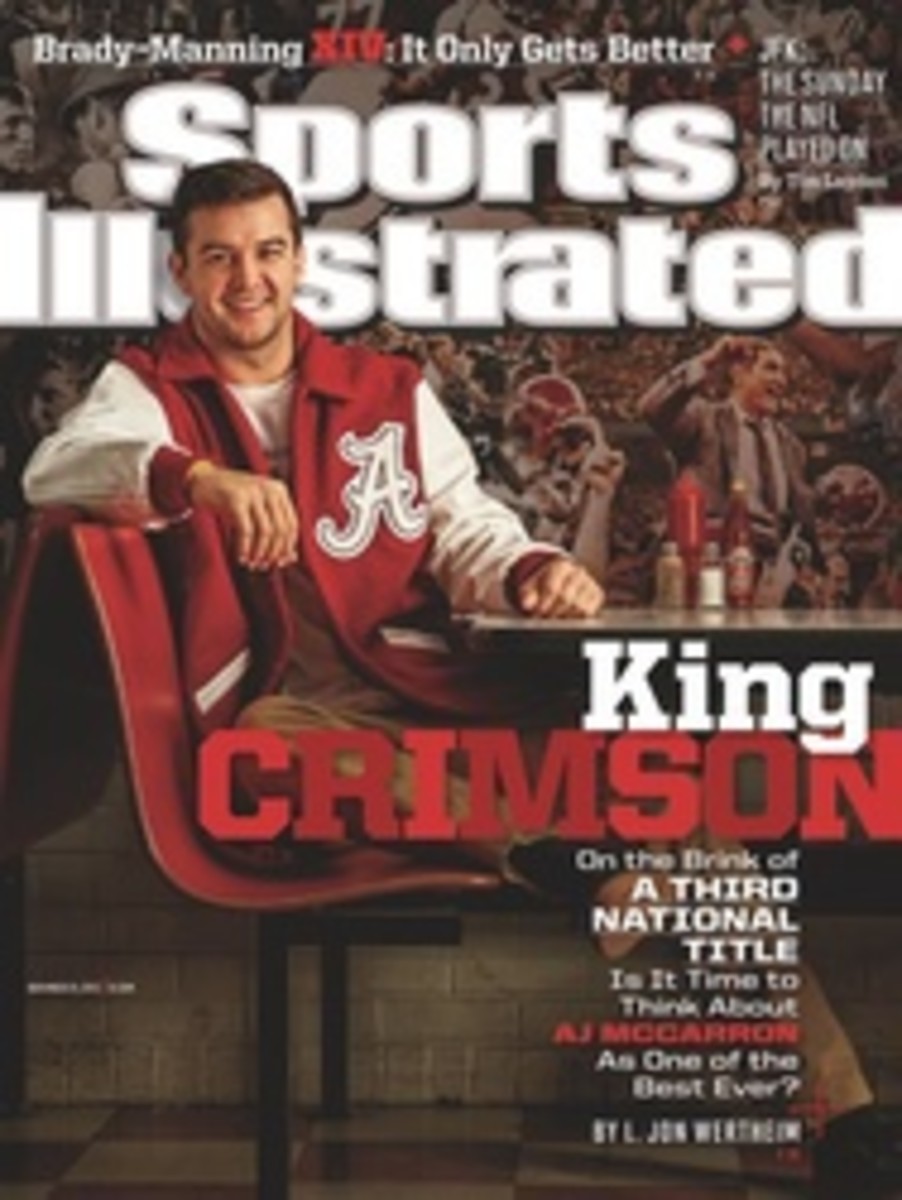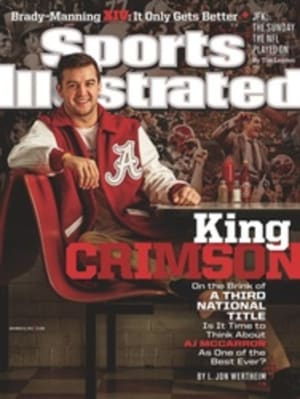
Gleam of Rivals
Years from now, wise men will look back in wonder. And they will say that this was the golden age, when a pair of quarterbacks of epic greatness overlapped so fully and so frequently that it was almost like watching busts from Canton rise up and throw dueling post patterns. This Sunday night in New England, Tom Brady and Peyton Manning will compete on an NFL field for the 14th time in their parallel careers. Brady will, as always, dress for the Patriots; Manning will make his second consecutive trip to Foxboro as a member of the Broncos. At stake will be a victory in the football dog days of late November—one more win banked in pursuit of home playoff games, one more loss making more real the prospect of a wild card. But the subtext is more meaningful: Two of the three (or is it five? ten?) best quarterbacks in the history of professional football will once more share time and space, sharpening the plotlines that have connected—and divided—them since their first meeting on that very same field a dozen years ago.
It is rare that the best of all time appear on the same stage so often, walking in lockstep from professional infancy to what surely must be first-ballot Hall of Fame induction. (And how appropriate it would be if they were to retire at the same time, donning yellow blazers together five years later, Brady naturally looking sharper in his.) More often, sports dangle historic matchups in front of us and then pull them away. Larry Bird and Magic Johnson, for all the lore that attends their rivalry, met just three times in the NBA Finals during their 13-year common careers. (NBA regular-season meetings carry far less weight than those in the NFL.) Ali and Frazier fought only three times, just once for the heavyweight title. Over their shared 56 major starts, Tiger and Phil have just four times reached the back nine together in contention. (One exception: Roger Federer and Rafael Nadal have met 32 times.)
Brady-Manning is rare even among great quarterbacks. John Elway and Dan Marino both came into the NFL in 1983; Marino played 17 seasons and Elway 16, yet they faced each other on only three occasions, Marino winning two and Elway taking the lone playoff matchup. Marino was in the league with Joe Montana for a dozen years, and they played just three times, the most significant being the 49ers' Super Bowl XIX victory in January 1985, Marino's second year. Terry Bradshaw and Kenny Stabler were both rookies in 1970, and each stayed in the NFL for 14 seasons, yet they met only nine times, Stabler winning five. Troy Aikman and Brett Favre spent a decade together as pros and played seven times; Favre won only the last meeting, a November matchup during the Packers' Super Bowl year of 1997.
The closest football parallel to Brady-Manning is more than four decades old. Bart Starr and Johnny Unitas came into the NFL in 1956, and over the next 11 years their teams split 17 games in which each played quarterback. Unitas's Colts dominated first, in the late '50s, and Starr's Packers did likewise as the Lombardi dynasty found its stride in the early '60s. Their last meeting was in '67, when Unitas threw two fourth-quarter TD passes to beat the Pack 13--10 at Memorial Stadium in Baltimore. Green Bay went on to win its second consecutive Super Bowl, over the Raiders.
Brady and Manning first faced each other on Sept. 30, 2001. It was the inaugural start of Brady's career, one week after Jets linebacker Mo Lewis knocked out Patriots QB Drew Bledsoe and 19 days after the attacks on 9/11. Their paths to that September afternoon were decidedly different: Manning, prince of a royal football family, started all but his first four games in four years at Tennessee and was the No. 1 selection in the 1998 NFL draft, by the Colts. Brady arrived at Michigan buried on the depth chart, sat for one year behind Brian Griese and then started for two seasons while holding off Drew Henson every day. He famously wasn't picked until the sixth round in 2000 and had to climb over John Friesz and Michael Bishop just to back up Bledsoe. On a cool, windy day coach Bill Belichick kept Brady on a short leash; the QB completed 13 of 23 passes for just 168 yards. But Manning was intercepted three times, and the Patriots rolled to a 44--13 victory en route to the first championship of the Brady-Belichick era. Indianapolis went 6--10 and fired coach Jim Mora, bringing in Tony Dungy.
The narrative has shifted several times in the ensuing years. By the end of the 2004 season, Brady had won three Super Bowls in four years and beaten Manning's Colts six consecutive times, including twice in the playoffs, '03 and '04. Manning won the league MVP in both of those years, the latter after throwing 49 touchdown passes, one more than Marino's 20-year-old record. The effect of this dynamic—Manning rolling up numbers while losing to Brady, who marched to Super Bowl titles—was to cast Manning as a compiler who couldn't win big titles (he was similarly disparaged at Tennessee while losing three times to Florida) and Brady as a trophy-hoarding gamer. It was manifestly absurd, but New Englanders in particular embraced it wholeheartedly.
This is another way in which the Starr-Unitas rivalry mirrors Brady-Manning. Unitas is remembered as a swashbuckling pioneer who elevated the art of play-calling and turned the two-minute drill into a weapon. Starr is regarded as Lombardi's game manager, though that damns him undeservedly—he also won three NFL championships and those first two Super Bowls. Unitas won two NFL titles and one Super Bowl.
Taking it off the football field, the parallel would be another one that New Englanders can appreciate: Wilt Chamberlain and Bill Russell. Chamberlain was a scoring and rebounding machine, the most dominant physical force in basketball history; he won two NBA championships, one each with the 76ers and the Lakers, while Russell and his Celtics won 11. There was also no shortage of matchups between those two. In the 1966--67 season, when the 76ers went 68--13 and won Chamberlain's only title in Philadelphia, five of those losses were to the Celtics, among nine meetings.
Yet slowly, for Brady and Manning, these roles shifted. Peyton finally beat Brady and the Patriots at Indy, in the 2006 AFC title game, en route to his first Lombardi trophy. Brady threw 50 touchdowns in the Patriots' unbeaten regular season the next year, but he lost to Manning's brother Eli in the Super Bowl. Each would lose another Super Bowl, each would miss a season (Brady 2008 with a torn left ACL; Manning 2011 with a neck injury), and each would return to play at a level matching his previous standard. As seasons passed, they became elder statesmen, entrenched in the history of the game. Manning is now second to Favre in career passing yards and touchdowns; Brady remains one of only four quarterbacks to have won at least three Super Bowls (with Bradshaw, Montana and Aikman).
They have also continued to drive the breakneck evolution of NFL offenses. The professional game had been tipping from the run to the pass since rules changes limiting downfield manhandling of receivers were first implemented in 1977, but that metamorphosis has accelerated with the arrival of increasingly better quarterbacks who pilot ever more sophisticated offenses. In '97, the last year in which neither Brady nor Manning played in the NFL, quarterbacks league-wide completed 56.2% of their passes for 201.8 yards per game and an average passer rating of 75.8. Through 10 weeks of 2013, those figures were significantly up: 61.4%, 239.0 yards, a rating of 84.4.
Quarterbacks have always commanded an outsized place in the game, but their importance has intensified with the proliferation of no-huddle offenses and the sport's crackdown on defensive kill shots, which has emboldened receivers. Big plays are there for the taking, but only if the passer is skilled enough to take them. Brady and Manning are iconic, from the latter's shotgun oratories (Omaha! Omaha!) to his dancing feet to his wobbly-but-deadly-accurate spirals to the galloping impression, as he stands in the pocket, that he's a Ph.D. engaging teenagers in a battle of wits. Brady, likewise, is the classic pocket thrower, with his long stride and high release (as well as every bit of Manning's brainpower). If the league had a human logo like the NBA's, it would be Brady, the ball held above his shoulder, cocked and ready. A generation rises on the shoulders of these two, most notably Drew Brees and Aaron Rodgers, but also Andrew Luck, Cam Newton, Matthew Stafford and Russell Wilson.
Yet, to their audiences, Brady and Manning remain dissimilar in significant ways. By the choices he's made as a pitchman, Manning comes off as the type of neighborly sort who would enjoy scarfing down pizza while listening to country music and telling jokes on the back deck. Maybe throw the ball around a little. Brady, with a pile of high-end fashion shoots and a supermodel wife, seems like a guy who might smile and wave back from the red carpet. Both images are ultimately caricatures that serve to give fans a reason to like or dislike.
They arrive in Foxboro as old men, at least in football years: Brady at 36 and Manning at 37, neither with many seasons left. Manning is on pace to take down most existing significant single-season passing records, but he is also battling a high right-ankle sprain. Brady is having the worst statistical year of his career but has frequently performed magic with overmatched, inexperienced receivers. There are rumors of hand and shoulder issues.
But January beckons even louder. Their meetings dwindle to a few, each more precious than the last.
P. 22
Pro Football
Pot in the NFL
P. 27
Extra Mustard
P. 28
Tech
Golf Gadgets
P. 30
Faces in the Crowd
P. 32
Dan Patrick
Bryce Petty
P. 34
The Case for
Dario Franchitti
Go Figure
Who's been the better QB over 13 Brady-Manning meetings? Here's head-to-head fodder for both sides of the argument
he was checking his route and threw right to me. He makes a lot of dummy calls, but you'll often know what the route is."
FLASHBACK SCOUTING PEYTON MANNING
"He isn't John Elway, Dan Marino or Jim Kelly, but he's as good as it gets in college football. A lot of these teams in the NFL are desperate for quarterbacks, and he's the best out there, with Ryan Leaf a real close second."
—Mel Kiper Jr., ESPN, 1998
Win by a Hair
Tracking the archrivals' ever-changing—or, in Manning's case, totally static—coifs
BRADY
MANNING
2001
2003
2005
2007
2010
2012
2013
PHOTO
WINSLOW TOWNSON FOR SPORTS ILLUSTRATED
PHOTO
LYNN JOHNSON FOR SPORTS ILLUSTRATED (BRADY)
PHOTO
ROBERT BECK/SPORTS ILLUSTRATED (MANNING)
PHOTO
DAMIAN STROHMEYER/SPORTS ILLUSTRATED (BELICHICK)
PHOTO
KEVIN RIVOLI/AP (MORA)
PHOTO
BOB ROSATO/SPORTS ILLUSTRATED (DUNGY)
PHOTO
AL TIELEMANS/SPORTS ILLUSTRATED (CALDWELL)
PHOTO
DAVID BERGMAN FOR SPORTS ILLUSTRATED (FOX)
TWO PHOTOS
JOE ROBBINS/GETTY IMAGES (MACKLIN, CLEMENTS)
PHOTO
BOB LEVEY/GETTY IMAGES (HALL)
PHOTO
CARLOS M. SAAVEDRA FOR SPORTS ILLUSTRATED (TAYLOR)
PHOTO
KIRBY LEE/WIREIMAGE.COM (EDWARDS)
PHOTO
GEORGE GOJKOVICH/GETTY IMAGES (HALL)
PHOTO
ANDY LYONS/GETTY IMAGES (BUCKLEY)
PHOTO
SCOTT CUNNINGHAM/GETTY IMAGES (DECOUD)
PHOTO
DAMIAN STROHMEYER/SPORTS ILLUSTRATED (LAW)
PHOTO
DAVID BERGMAN FOR SPORTS ILLUSTRATED (JAMMER)
PHOTO
ELISE AMENDOLA/AP (BRADY)
PHOTO
NFL PHOTOS/GETTY IMAGES (WALKER)
PHOTO
BRIAN BRAINERD/THE DENVER POST/GETTY IMAGES (PLUMMER)
PHOTO
HARRY CABLUCK/AP (WILLIAMS)
PHOTO
HEINZ KLUETMEIER/SPORTS ILLUSTRATED (KOSAR)
PHOTO
AP (ABDUL-JABBAR)
PHOTO
DOUG PENSINGER/GETTY IMAGES (MANNING)
PHOTO
M. DAVID LEEDS/GETTY IMAGES
PHOTO
NFL PHOTOS/AP
PHOTO
PETER READ MILLER/SPORTS ILLUSTRATED
PHOTO
SIMON BRUTY/SPORTS ILLUSTRATED
PHOTO
TONY DING/AP
PHOTO
EVAN AGOSTINI/AP
PHOTO
DIMITRIOS KAMBOURIS/GETTY IMAGE
PHOTO
WILFREDO LEE/AP
PHOTO
NFL/WIREIMAGE.COM
PHOTO
JOHN BIEVER/SPORTS ILLUSTRATED
PHOTO
HEINZ KLUETMEIER/SPORTS ILLUSTRATED
PHOTO
JOHN BIEVER/SPORTS ILLUSTRATED
PHOTO
ROBERT BECK/SPORTS ILLUSTRATED
PHOTO
ROBERT BECK/SPORTS ILLUSTRATED
THIRTEEN PHOTOS
FIFTEEN ILLUSTRATIONS

